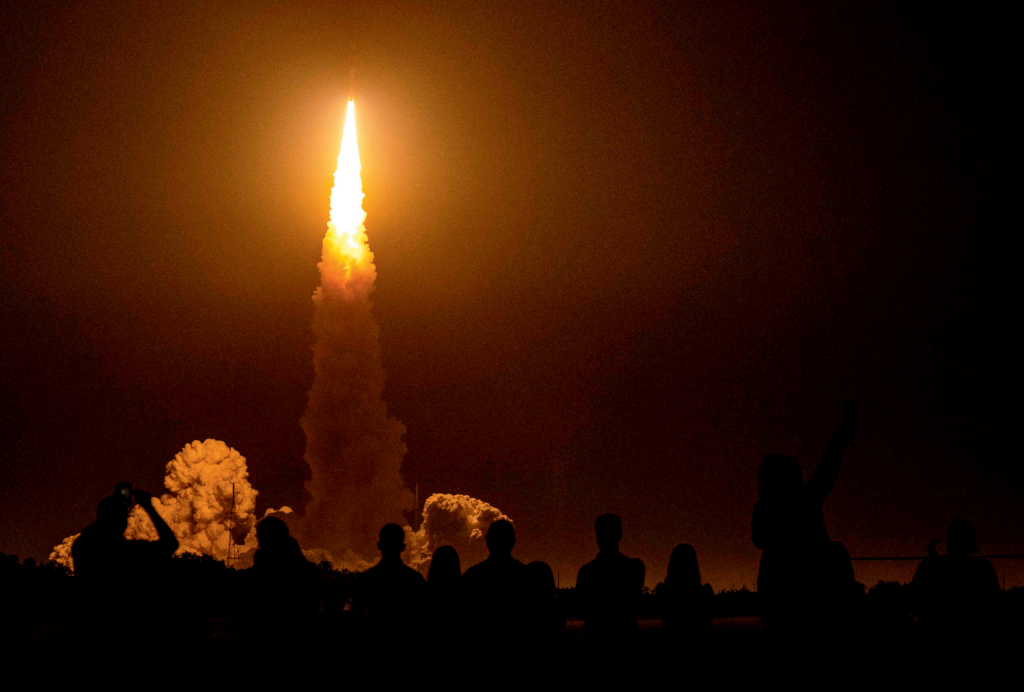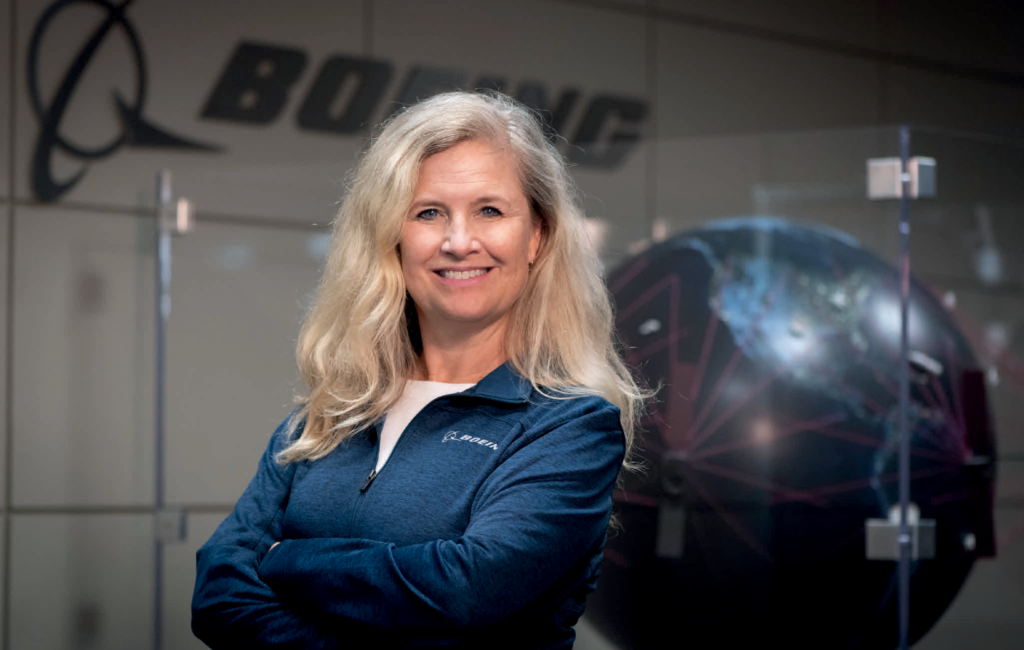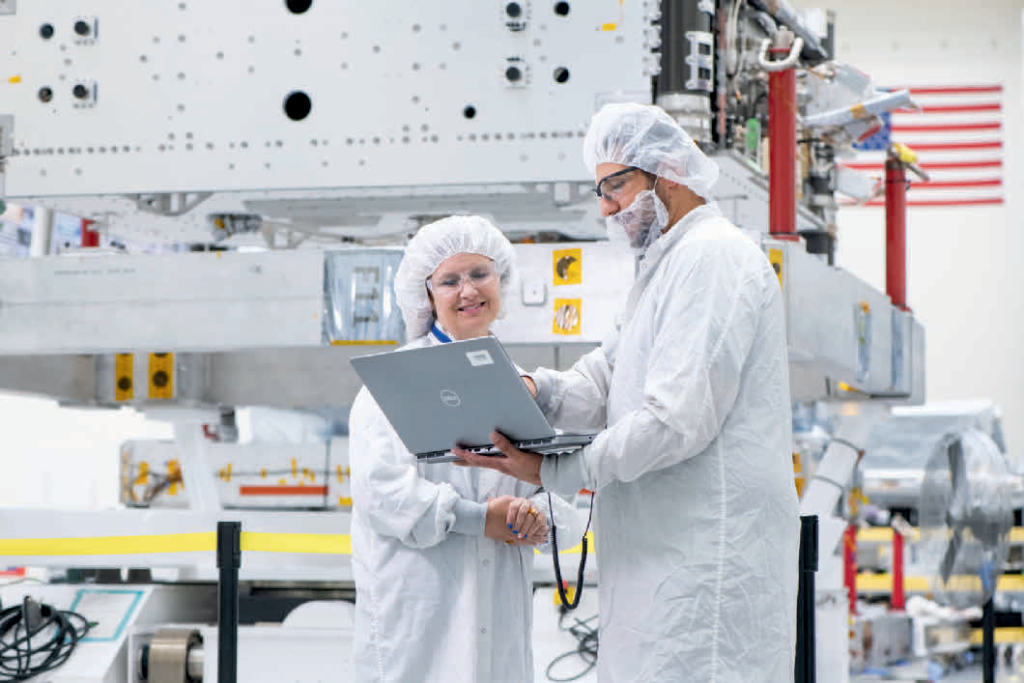
Michelle Parker (GEN’93, GR’00) has always been interested in space exploration. “As a child, I would draw the solar system on my chalkboard. I knew all the names of the planets,” she says. “I would watch the space shuttle launches.”
That skyward enthusiasm was complemented by an early affinity for math and science, and a deep curiosity that led her to follow her engineer dad around the house as he fixed things. After a high school physics class opened her eyes to the idea that “you can describe the universe with mathematics,” she decided she, too, wanted to be an engineer. Ultimately, the choice led her to a job at Boeing, and an up-close view of spacecraft liftoffs.
Parker was at the Kennedy Space Center two years ago to see NASA’s Artemis I launch at 1:47 a.m. Eastern and usher in a new era of deep space exploration. The uncrewed flight was a major milestone in the preparation for Artemis II going up in 2025, with four astronauts who will become the first humans to orbit the moon since 1972. Long term, the program aims to establish a lunar base and send humans to Mars.
As Chief Engineer of Space and Launch, Parker led the Boeing team that designed and built several key components of the new Space Launch System rocket to propel Artemis missions out of Earth’s atmosphere. “Launches never get boring, but that was probably one of the most exciting,” Parker says of Artemis I. “The loudest, brightest launch that I had seen, and everything went perfectly. For me, from a thermofluids background, it was just amazing to see that rocket, all the propellant, thrusters, and everything that it took to bring that system together.”
Parker has since been promoted to Vice President of Boeing Space Mission Systems, where her portfolio includes commercial and government satellites, and the reusable space plane X-37B. Based in Los Angeles, she has worked at Boeing for three decades, in both technical and business leadership positions. In each role along the way, she says, she has applied her Penn Engineering master’s and doctorate degrees in Mechanical Engineering and Applied Mechanics (MEAM) to forge a career where she gets to “push boundaries” and “design the next set of products that will take humankind further into space.”
Although her current job means she’s “not in the nitty-gritty technical details” every day, she is still fueled by the same passion that inspired her to sketch planets in chalk as a child.
“It’s a really interesting time,” she says. “We’re talking about colonies on the moon, going to Mars. All of these things that we’ve talked about for decades are actually within our grasp and will likely happen in the next few decades or so.”

Flight Test
Parker grew up near Philadelphia, in South Jersey, and she was familiar with Penn. So after getting a bachelor’s in Mechanical Engineering at Lehigh University and deciding to move directly on to pursuing advanced degrees, she chose Penn Engineering and specialized in thermofluids. “I fell in love with the campus as a graduate student,” she says.
Even now when she returns to visit, she makes time to stroll Locust Walk and around the Towne and Moore buildings. She appreciates the changes: “It’s just great to see the growth of the campus, and yet it still remains core to what it’s always been.” One thing has stayed the same, however. She always stops by a food truck for a soft pretzel and coffee, her grad school fuel.
Inside Penn’s classrooms, she was awed by Michael A. Carchidi, Senior Lecturer in MEAM, who “would just write on the board, with no notes,” in vector calculus. MEAM professor Haim H. Bau’s chaos theory class “spoke to me,” she says. “The whole mathematical representation of chaos results in these beautiful plots and graphical representations of the equations.”
After two years, she finished her master’s, her qualifying exams and her Ph.D. coursework.
Then she pressed pause.
“I felt like I really needed to go get some real-world work experience and see exactly how I was going to use this knowledge that I now had,” she says.
Instead of digging in for a dissertation, she moved to Los Angeles in 1995 for a job as a thermophysics engineer at what was then Hughes Space and Communications. (Hughes became part of Boeing in 2000.)
After about a year, she was ready to return to Penn, equipped with a clear vision for her doctoral research and a Hughes Fellowship. She would conduct experiments and analytical work in L.A., and return to Penn for a month or so each semester to work with Portonovo S. Ayyaswamy, now Professor Emeritus in MEAM.
For her dissertation, Parker tapped into her passion for space and also incorporated her on-the-job experience in heat transfer for mechanical systems. Her research focused on a device to prevent satellite electronics from overheating: the loop heat pipe.
Standard heat pipes had long been used to maintain optimal operating temperatures, but satellites were getting bigger and loaded with more and more electronics. A bigger radiator to emit heat would help, but as with all things space travel, there are size restrictions. The solution: folding radiators that could open up and deploy in orbit to provide more cooling surface. (Think of a trifold brochure.) However, that meant the pipe transferring the heat would need to bend as well. Standard heat pipes weren’t flexible. Enter the loop heat pipe.
When Parker chose her subject, this flexible solution was under development, but engineers didn’t know how the device would behave in space or affect satellites’ temperature-regulating processes. She modeled the practical application of the loop heat pipe, running simulations and analyzing potential behaviors.
In late 1997, she and her colleagues got the chance to put a loop heat pipe experiment on the 24th flight of the Space Shuttle Columbia. The data informed the models Parker was developing, and the first satellite using a loop heat pipe launched in late 1999. The device continues to be a core part of Boeing’s high-power satellites, and Parker still feels a personal connection to that Columbia STS-87 mission.
“I take my family to the California Science Center, where they have all the patches for all the space shuttles,” she says. She points to the one stitched with Space Shuttle Columbia STS-87 and tells her kids, “That was mine.”

Onward Journey
Boeing has been making satellites since the 1960s, and that legacy is meaningful to Parker. Electrical engineer Harold Rosen, who designed one of the earliest models, Syncom 2, was at the company well into the 2000s. “I still used to see him and talk to him at the copy machine,” she says. “So there is this historical connection for those of us who have crossed paths with some of the originators of this space ecosystem that we’re seeing grow so extensively today.”
Looking toward that future, Parker often makes time to connect with students and early-career professionals who may follow in her footsteps. Her advice for them is shaped by her own professional motivators and achievements. While technical skills are a must, she says, communication and teamwork are vital.
“The systems that we build for space, like satellites, rockets or space stations, are complex. The ability to collaborate across different subsystems and come up with an overall system that’s going to operate well is extremely important,” she says.
Parker sees the increase in the number of women enrolling in engineering schools as a “trend in the right direction” because “whether it is women or diversity of background, a team that is bringing different ideas, different learnings into a discussion or a design meeting really enriches the conversation, and those different perspectives help us get to the best solution.”
Still, not every day is easy, even when you love your job as much as Parker. That’s why she never forgets to mention the usefulness of resilience.
“There are setbacks, there are anomalies, and that’s what makes it interesting,” she says. “Space is not an easy domain. We are doing new things every day, and when we figure out how to do those things, it’s extremely exciting.”
Story By Janine White / Photos of Dr. Parker courtesy of Boeing
